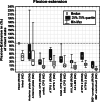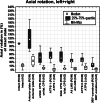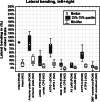The stabilizing potential of anterior, posterior and combined techniques for the reconstruction of a 2-level cervical corpectomy model: biomechanical study and first results of ATPS prototyping
- PMID: 20589516
- PMCID: PMC2997200
- DOI: 10.1007/s00586-010-1503-x
The stabilizing potential of anterior, posterior and combined techniques for the reconstruction of a 2-level cervical corpectomy model: biomechanical study and first results of ATPS prototyping
Erratum in
- Eur Spine J. 2011 Sep;20(9):1579. Willke, Hans-Joachim [corrected to Wilke, Hans-Joachim]; Gräf, Nicolaus [corrected to Graf, Nicolaus]; Middendorf, Stefan [corrected to Midderhoff, Stefan]
Abstract
Clinical studies reported frequent failure with anterior instrumented multilevel cervical corpectomies. Hence, posterior augmentation was recommended but necessitates a second approach. Thus, an author group evaluated the feasibility, pull-out characteristics, and accuracy of anterior transpedicular screw (ATPS) fixation. Although first success with clinical application of ATPS has already been reported, no data exist on biomechanical characteristics of an ATPS-plate system enabling transpedicular end-level fixation in advanced instabilities. Therefore, we evaluated biomechanical qualities of an ATPS prototype C4-C7 for reduction of range of motion (ROM) and primary stability in a non-destructive setup among five constructs: anterior plate, posterior all-lateral mass screw construct, posterior construct with lateral mass screws C5 + C6 and end-level fixation using pedicle screws unilaterally or bilaterally, and a 360° construct. 12 human spines C3-T1 were divided into two groups. Four constructs were tested in group 1 and three in group 2; the ATPS prototypes were tested in both groups. Specimens were subjected to flexibility test in a spine motion tester at intact state and after 2-level corpectomy C5-C6 with subsequent reconstruction using a distractable cage and one of the osteosynthesis mentioned above. ROM in flexion-extension, axial rotation, and lateral bending was reported as normalized values. All instrumentations but the anterior plate showed significant reduction of ROM for all directions compared to the intact state. The 360° construct outperformed all others in terms of reducing ROM. While there were no significant differences between the 360° and posterior constructs in flexion-extension and lateral bending, the 360° constructs were significantly more stable in axial rotation. Concerning primary stability of ATPS prototypes, there were no significant differences compared to posterior-only constructs in flexion-extension and axial rotation. The 360° construct showed significant differences to the ATPS prototypes in flexion-extension, while no significant differences existed in axial rotation. But in lateral bending, the ATPS prototype and the anterior plate performed significantly worse than the posterior constructs. ATPS was shown to confer increased primary stability compared to the anterior plate in flexion-extension and axial rotation with the latter yielding significance. We showed that primary stability after 2-level corpectomy reconstruction using ATPS prototypes compared favorably to posterior systems and superior to anterior plates. From the biomechanical point, the 360° instrumentation was shown the most efficient for reconstruction of 2-level corpectomies. Further studies will elucidate whether fatigue testing will enhance the benefit of transpedicular anchorage with posterior constructs and ATPS.
Figures






References
-
- Acosta LF, Aryan HE, Chou D, Ames CP. Long-term biomechanical stability and clinical improvement after extended multilevel corpectomy and circumferential reconstruction of the cervical spine using titanium mesh cages. J Spinal Disord Tech. 2008;21:165–174. doi: 10.1097/BSD.0b013e3180654205. - DOI - PubMed
Publication types
MeSH terms
LinkOut - more resources
Full Text Sources
Medical
Miscellaneous

